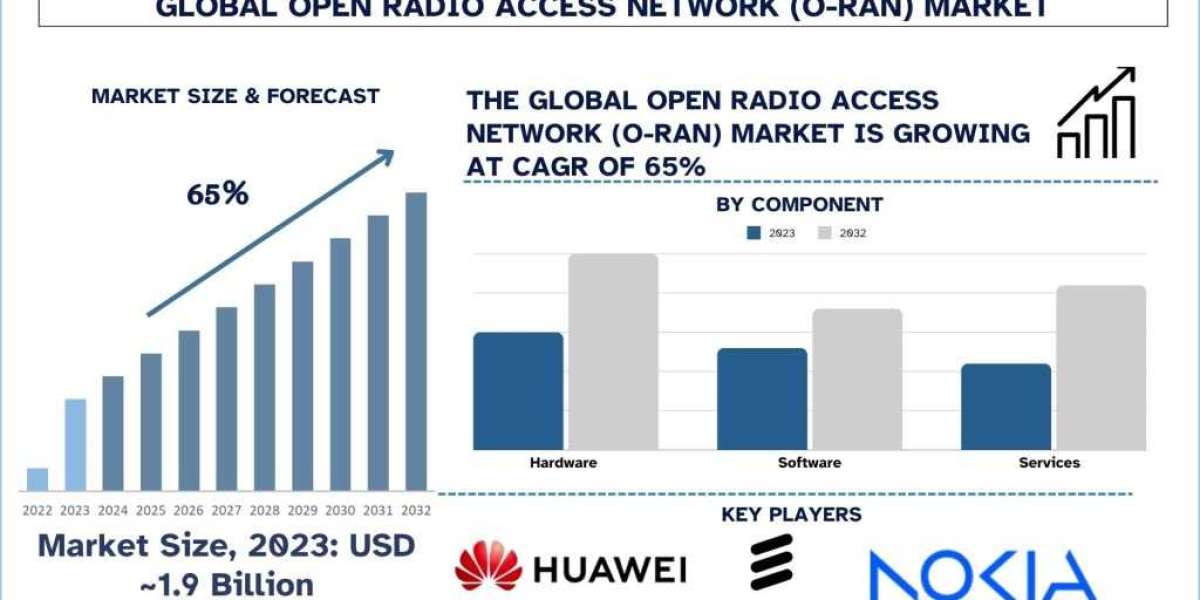According to the UnivDatos Market Insights Analysis, increased demand for 5G networks, rising demand for virtualization and cloud-based solutions, and increasing adoption of Software-Defined Networking (SDN) and Network Functions Virtualization (NFV) drive the Open Radio Access Network (O-RAN) market. As per their “Open Radio Access Network (O-RAN) Market” report, the global market was valued at USD 1.9 Billion in 2023, growing at a CAGR of about 65% during the forecast period from 2024 – 2032 to reach USD billion by 2032. The industry is witnessing important changes inspired by the introduction of Open Radio Access Network (O-RAN) technology. By encouraging openness and interoperability O-RAN is changing how mobile networks evolve. The attention from telecom companies and governmental bodies is growing toward this trend since it appears capable of challenging the dominance of a small group of major players in the network infrastructure market. O-RAN is rising as a vital driver for establishing more adaptable and affordable networks as the world moves towards 5G deployment and further.
Access sample report (including graphs, charts, and figures): https://univdatos.com/get-a-free-sample-form-php/?product_id=43194
The Basics of O-RAN
O-RAN fundamentally separates conventional network components so that network providers can combine solutions from various suppliers. O-RAN creates opportunities for competition and lowers costs differently from RANs that generally utilize integrated solutions from one vendor. It accomplishes this by utilizing standardized functionality and models that support the use of readily available hardware and cloud solutions.
The virtualization foundation of O-RAN employs software-defined networks (SDN) and network function virtualization (NFV) to simplify the adaptation of network functions. By following this solution providers can achieve better efficiency in scaling and respond promptly to customer requirements while reducing both expenses.
Trending News: Global Push for O-RAN Adoption
The significant progress in the O-RAN sector involves increased worldwide acceptance, especially in areas with deep investment in 5G networks. Several European countries have championed O-RAN due to its potential to lower their reliance on popular telecom gear suppliers such as Huawei, Ericsson, and Nokia.
On August 30, 2024, Ericsson (NASDAQ: ERIC) and Telstra announced a groundbreaking, world-first achievement in mobile connectivity with the deployment of Ericsson’s 4th generation of Radio Access Network (RAN) purpose-built compute platform, paving the way for a consistent 5G Advanced platform for Australia.
On September 25, 2023, Ericsson (NASDAQ: ERIC) underlined its commitment to lead the industrialization of Open RAN and bring the benefits of cloud-based open network architecture to the industry, including support for open fronthaul in its Cloud RAN and radio portfolios.
On April 18, 2024, Huawei Analyst Summit, Huawei launched its game-changing RAN Intelligent Agents. The RAN Intelligent Agents introduce a set of telecom foundation model, RAN digital twins system (RDTS), and intelligent computing power to empower 5.5G with intelligence, according to Eric Zhao, Vice President and Chief Marketing Officer of Huawei Wireless Network, highlighting that the RAN Intelligent Agents will reshape the OM process, network experience, and service model to help global operators achieve a leap in network productivity in the 5.5G era.
The U.S. Leads the Charge
The U.S. government strongly supports O-RAN to lessen Dependence on Chinese telecom suppliers. Through programs like the Open RAN Policy Coalition the U.S. dedicated large sums of money to fund O-RAN research and development in 2020. Verizon and Dish Network as well as ATT have commenced the rollout of O-RAN options within their networks. The company has agreed to develop a completely virtualized O-RAN 5G network which stands out among others.
On December 04, 2023, ATT announced plans to lead the United States in commercial-scale open radio access network (Open RAN) deployment. This industry-leading move, in collaboration with Ericsson, will further the telecommunications industry efforts and help build a more robust ecosystem of network infrastructure providers and suppliers. ATT’s spending could approach roughly $14 billion over the 5-year term of the contract with Ericsson.
O-RAN receives backing from the Federal Communications Commission (FCC) which has initiated multiple efforts to promote open standards in U.S. networks.
Japan and Asia-Pacific: A Growing Hub for O-RAN
NTT DoCoMo and KDDI have helped Japan become a vital player in the O-RAN sector. The world’s first completely virtualized cloud-native mobile network has been established by Rakuten using O-RAN methodologies. By showcasing the effectiveness of O-RAN on a large scale this challenging undertaking has placed Rakuten at the forefront of network innovation worldwide.
February 26, 2024 – NEC Corporation (NEC; TSE: 6701) announced its selection by NTT DOCOMO, Inc. (DOCOMO) as a virtualized radio access network (vRAN) vendor for DOCOMO’s nationwide 5G commercial network services. Going forward, NEC plans to provide DOCOMO with vRAN for use in creating flexible and highly scalable 5G networks to be operated on the company’s commercial networks.
Collaboration with partners such as NEC and Fujitsu as well as Samsung, and NTT DoCoMo was key in supporting the growth of O-RAN and building fully compatible solutions. ATT’s Open RAN plan is for 70% of its wireless network traffic to flow across open-capable platforms by late 2026. The company expects to have fully integrated open RAN sites operating in coordination with Ericsson and Fujitsu, starting in 2024. The country’s significant backing for O-RAN fits well with its wider aspirations of stimulating technological development and minimizing the use of foreign partners.
For a detailed analysis of the Global Open Radio Access Network (O-RAN) Market browse through – https://univdatos.com/report/open-radio-access-network-market/
The Future of O-RAN
Operators will explore O-RAN more frequently as they seek flexible and cost-effective methods to meet the growing demand for mobile data growth tied to 5G and forthcoming technologies.
As we look forward to the next few years O-RAN will be essential for progressing edge computing and network slicing technologies. As these innovations advance O-RAN will construct frameworks for networks that can meet the different demands of telecom.
Conclusion
The expansion of O-RAN indicates a vital transformation in the aspects of network design and operation for mobile services. O-RAN is poised to change the worldwide telecommunications landscape by supporting accessibility and enhancing innovation with a range of suppliers. This technology will be embraced by governments and telecom firms worldwide to enhance O-RAN’s expansion and introduce new paths for upgrading networks and enhancing digital advancements.
Related Report
Cyber Insurance Market: Current Analysis and Forecast (2024-2032)
Digital Human Avatar Market: Current Analysis and Forecast (2024-2032)
Virtual Influencers Market: Current Analysis and Forecast (2024-2032)
Diversity and Inclusion (DI) Market: Current Analysis and Forecast (2024-2032)
Container Orchestration Market: Current Analysis and Forecast (2024-2032)
Contact Us:
UnivDatos Market Insights
Email - contact@univdatos.com
Contact Number - +1 9782263411
Website - https://univdatos.com/







